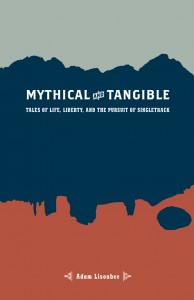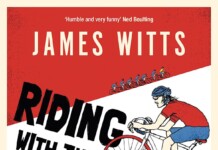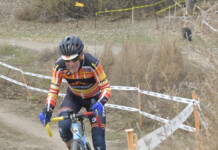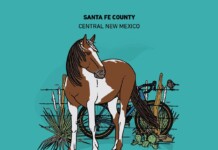
[The following is an excerpt from Mythical and Tangible: Tales of Life, Liberty, and the Pursuit of Singletrack by Utah writer and rider Adam Lisonbee. It was released in May 2011. This is his first book. It can be purchased in either paperback or digital editions at www.grizzlyadam.net/my-book.]
It was a few minutes after 6am, a cold, clear August morning in the mountains. I pedaled my bike above Soldier Hollow and up into the Wasatch Back. The sun was stretching itself over the tall mountains in the east. The effort of the climb warmed my blood. The goosebumps and shivers gave way to sweat and huffs and puffs.
Four hours, and 4000 vertical feet later, I stood once again on the Ant Knolls, that familiar and favorite saddle of rugged rock, pine, and primrose. And once again, I looked out over the sea of trees and land and folded mountains before me. I breathed deeply, letting the clean, fragrant mountain air seep into my lungs. I relished the moment. I wished, wistfully, that I could stay there indefinitely. To sit and watch time pass on and on. Days into weeks into years into forever. I yearned to sit long enough to watch the mountain crumble into dust, to see nature at its work. To witness erosion.
Recently, an arch at the Arches National Park fell apart. Collapsed. Died. Was it global warming that killed it? Industrial tourism? No. It was just an arch that fell. Brought to the earth by the very wind and rain and heat and sun and air and time that created it. From dust to dust. The Lord giveth, the Lord taketh. All things in their natural order.
I was still on the Knolls. Reluctantly I continued on my way. Through the aspen forests and the high meadows, and over the narrow ridge tops. The singletrack in this remote place above American Fork Canyon is a little visited gem, a hidden and fantastic line of dirt through thick aspen forests, across steep ridges and above the din and dust and static humanity of the more well-traveled trails far below in the bowels of the canyon. The monumental effort required to arrive at that place is worth every bead of sweat, and every step of hike-a-bike.
I plunged off of Mill Canyon Peak and into the dense scrub brush and baby pines below. In the distance, I could hear the roar of countless ATVs. I was nearing the territory where the engine rules and reigns in blaring tyranny. The hotbed of Utah redneckism, where beer cans litter the road, the air is humid with exhausted fuel, and entire families pile onto a single four-wheeler and speed along the road at 50 miles per hour. It is the outdoor version of dragging Main Street. Up and down the canyon road they go, never arriving at any destination. Just up and down. Burning fuel, looking stupid, and turning the road into a spongy mess of churned and burned dust.
A hero on a motorcycle whipped in front me, fishtailing his rear wheel and gassing the engine. Dust and rocks spewed into my face. Behold, the noble civility of a Neanderthal with horsepower! I continued to climb through the dust and the noise. I knew that there was a point on this mountain road where the engines stop and venture no further. Where once again the quiet of the high country settles and calms, a place where the awkward wheels of the ATVs cannot go. I fled to that spot, and rejoiced when I rode into the trees uninterrupted and unseen by those awful and polluting agents of destruction. Harsh words for simple ATVs? Perhaps.
As I ascended above the bedlam of the recreational motorists, I wondered if they ever really saw the beauty around them. Do they ever turn the engine off and listen, or look? There is more to see and to hear and to be a part of in the mountains than most people ever realize. It is not enough to drive along the roads and paths and the National Parks and the Scenic Byways. Get out. Walk. Feel the burn of thin air coursing through your lungs. Let the wind sting your face, the rain pound your back. Feel the ache in your thighs and feet. Stare in terror at a mountain lion. Get out of your vehicles!
My inner Abbey is surfacing. Edward Abbey—desert poet, anarchist, hater of the Glen Canyon Dam (lover of the Glen Canyon), bureaucracy, overgrazing, strip mines, and industrial tourism. Abbey’s writings peeled away the layers of nonsense and commotion that dominate modern, urban, and suburban life and revealed a quiet, peaceful, and wonderful world where simplicity and good friends were all anyone needed. Do people today even see the mountains or the deserts anymore? Or are the wilds just empty spaces, necessary burdens, a thing to be crossed (and mined and deforested and overgrazed) while one travels between the sheet metal cities full of lights and people and things?
A man can and should get lost once in a while. It will remind him of where he is—and where he ought to be going.
I climbed higher into the mountains as the sun started to drop below them. Another summer day was coming to a close. I took in a few more deep breaths, letting in the pine and the sage and the flowers. There was a hint of autumn in the air. I could taste it, smell it. I watched the leaves on the quaking aspens shiver, and knew that within weeks they would yellow and red and orange before falling to the earth. Collapsing. Dying. Just like Wall Arch.
I discovered Edward Abbey long after I ought to have. As a native of Utah, and someone who has traveled to Moab and other desert locations since I was a child, I grew up with a deep love for that improbable landscape. And yet I had never heard of Edward Abbey until well into adulthood.
Upon reading the first several pages of Desert Solitaire, I realized that I was reading the words of a kindred spirit. His writing is both realistic and mythical, capturing the essence of the landscape, while paying homage to the ancient presence of those who have come before. He understood that the canyon country was home to the Ancient Ones, and that they still linger within the deep recesses of both imagination and reality. Or, as he wrote of his first visit to the American Southwest, “For the first time, I felt I was getting close to the West of my deepest imaginings, the place where the tangible and the mythical became the same.”
It is that fusion of the tangible and mythical that pulls me back into the labyrinth of the desert each year. That painted landscape—the handiwork of time, wind, sun, and the overly creative impulses of God—is a vast and empty masterpiece for each of us to explore and discover. There is no place like the hoodoo of Moab and there is no maze like The Maze. Surreal and stone. The canyon country is the collision of rock and imagination, the mythical and the tangible—one need only stand in bewildered reverence at Grandview Point to understand.
Abbey is remembered for being an environmental anarchist, defender of the wild, fierce critic of government, industrialism, and technology—and certainly he was those things. But he was also an idealist, and he understood that idealism was ultimately impractical and impossible. Perhaps that is why he was so critical. He knew that he was fighting against the inevitability of growth, progress, and the American notion of manifest destiny. In Desert Solitaire, he lamented that:
“Arches National Monument has been developed…you will now find serpentine streams of baroque automobiles…elaborate house trailers of quilted aluminum…knobby-kneed oldsters in plaid Bermudas buzz up and down the quaintly curving asphalt road on motorbikes…Progress has come at last to the Arches, after a million years of neglect. Industrial Tourism has arrived.”
Indeed.
And yet, there are still wild places in the world, even within the boundaries of Arches National Park. Thankfully, those wild and rugged places are generally difficult to arrive at. The softness of the American way of life frowns upon the physical effort needed to see—and be in—the wilderness. Paved roads have snuck into the mountains and the deserts, but they only go so far. There are not many who are willing in this age of air conditioned adventuring to get out and feel the heat or the wind. The pain of an elevated heartbeat and coursing lactic acid have picked up where Abbey—and Hayduke—left off. The new saboteur of industrial tourism is physical discomfort.
Nevertheless, there are those who succumb to that innate desire to see a little better, with more clarity, and from a more interesting point of view. Brave blue-haired ladies and old curmudgeons trudge the well-worn path to Delicate Arch. Young kids skip and hop while dragging their reluctant parents across the sandstone. The effort rewards those who dare to leave the confines of the automobile with a sight so impressive and so magnificent that there are no words to adequately describe it.
The improbability of Delicate Arch is astronomical, and yet there it stands.
Those who take the time and steps to stand underneath it are forever changed. Even the very perimeters of the wild and rugged places of the desert and the mountains can purge the toxicity of asphalt and fluorescent from the human soul.
However, I read Abbey with mixed reactions. I like to think I am a practical person. I like to think that dams and roads and that “small dark cloud of progress” are making life better, easier, and more productive. But I also see the beauty and simplicity in the slow paced, hard-earned existence of his idyllic vision. Can there be both? Can man be at once solitary and societal? “The only thing better than solitude,” Abbey realized, “is society.”
And so that paradox in which he lived, is the same paradox with which I read his work. The machine of urbanization is simply too powerful to stop. But it feels good to oppose—to slow it down a little and escape into the mountains and live for a time as those Ancient Ones. At least as they would have lived had they had gas stoves, lightweight tents, water filters, LED headlamps, and freeze-dried beef stew. The exploration of the wilderness today is faster and more efficient than that of a generation ago. And while progress has helped our gear become lighter and cheaper and more reliable, the spirit that drove men into the unknown back then is the same today. We venture into the forests, the canyons, and mountains looking for answers—to know the unknown. The tangible and the mythical.
The small, but growing movement of multi-day, self-supported mountain bike racing is a manifestation of that explorative spirit. Intrepid bike riders pedal into the remote and empty spaces of the West, from Moab to Denver and from Canada to Mexico. Even within the chaos of the surrounding urban life, riders find a certain peace and solitude as they travel from town to town, and trail to trail.
And what for? To discover, to learn, to know.
Details are often unspoken and often unknown, until, like a flash of light they come crashing down on the mind and heart of the individual. Hidden truths are laid bare as one descends into the inner depths of human motivation and thought. The triumphs of the mind and body are amplified by the actual landscape. In other words, finding life in the vast caverns of human doubt is appropriate and beautiful, especially so in the open spaces of the wilderness.
Like Cactus Ed himself, the wild of the desert, and the desire and effort to explore its depths, is that collision of the tangible and the mythical. Over time, the very real and very hard-earned efforts of crossing the contours of the landscape become a distant memory, a story, a legend. We pass through the wild places like the wind. We come with a whisper, and then we are gone. The stoic, eternal earth watches with indifference as we glide through time and space.
Meanwhile, the sun continues to rise and fall. Wind, rain, heat, and cold whip away at the sandstone of the Arches and the peaks of the Rockies. Life rambles onward into the distance. Wilderness—actual and otherwise—persists, despite the best efforts of progress and machine and modernity to swallow it into the depths of concrete and the mental subterfuge of apathy and ignorance. Wilderness is dead. Long live wilderness.











